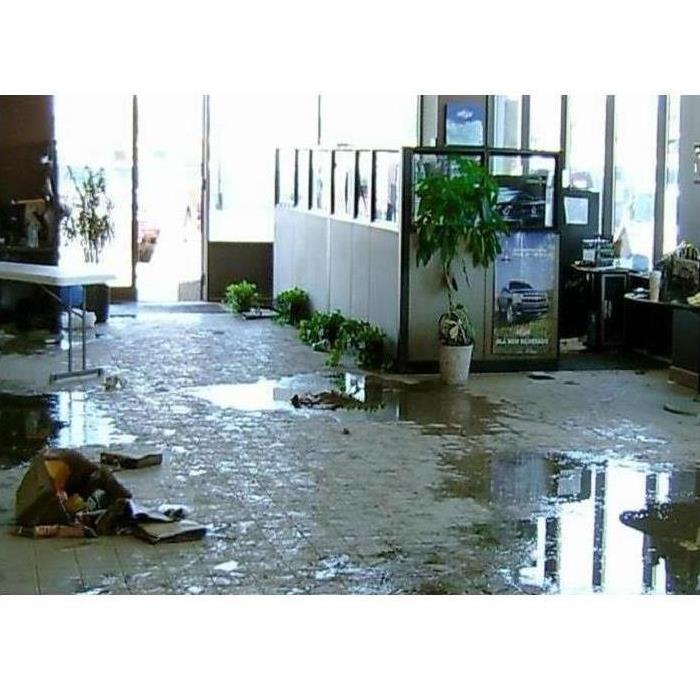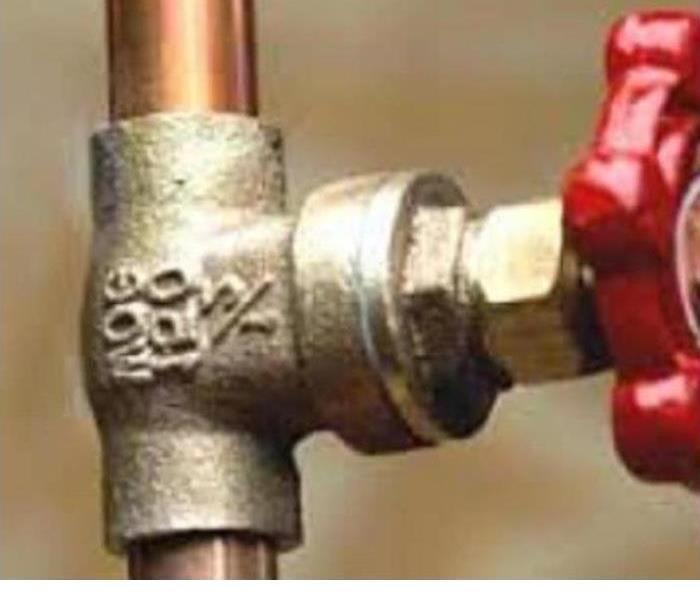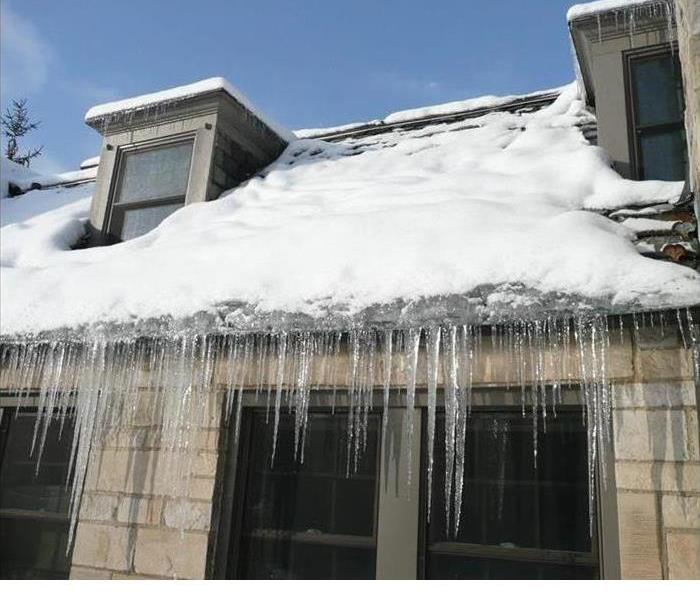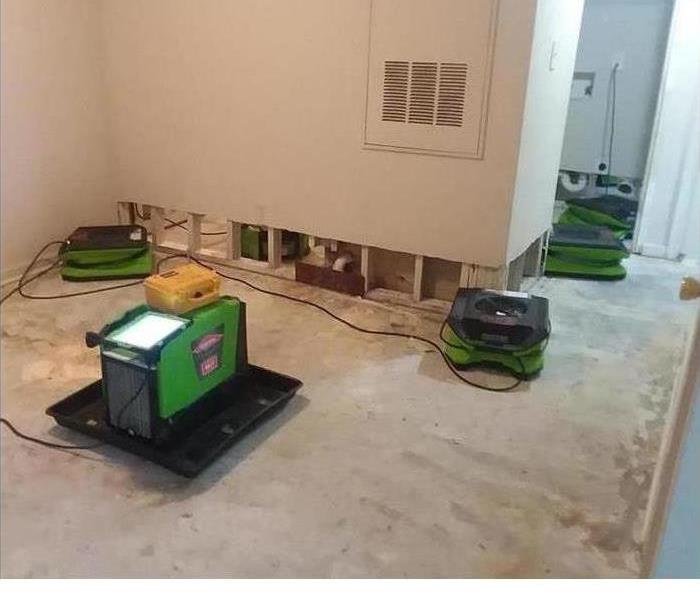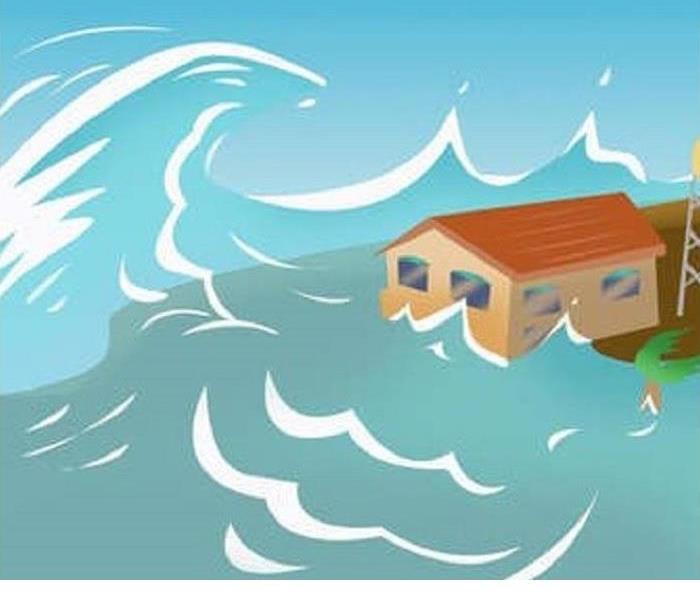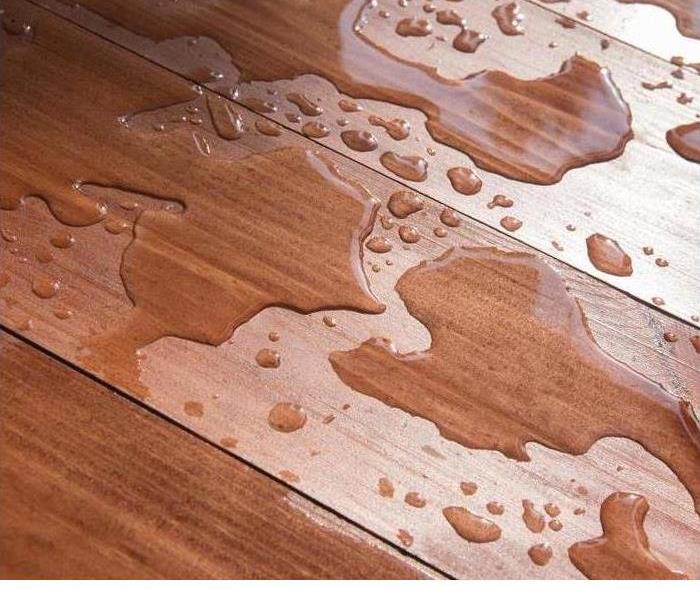Recent Water Damage Posts
How Gutters Keep Your Basement Dry
4/12/2024 (Permalink)
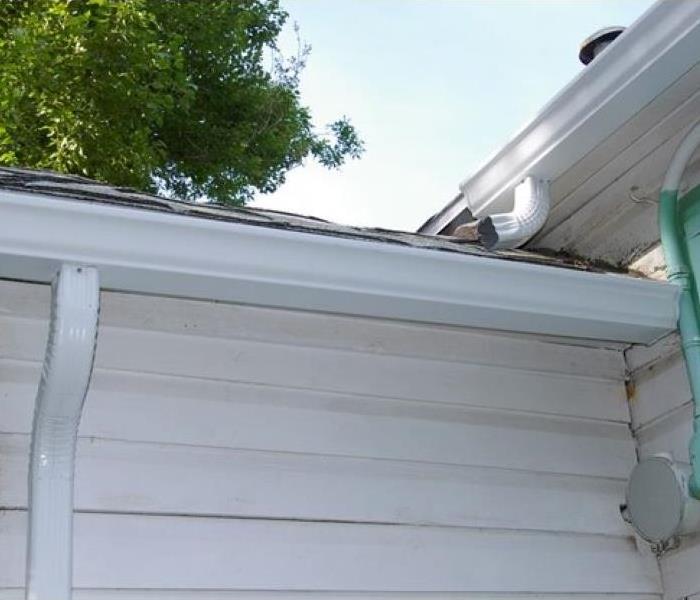 Protect your basement from water intrusion. Install quality gutters and keep them clean!
Protect your basement from water intrusion. Install quality gutters and keep them clean!
Basements are often an important space of a home, providing valuable storage space or even extra living areas. However, they're also vulnerable to water damage, which can lead to costly repairs. One crucial line of defense against basement flooding is often overlooked: gutters.
Gutters play a pivotal role in keeping your basement dry by managing rainwater runoff effectively. When rain falls on your roof, gutters collect the water and direct it away from your home's foundation. Without gutters, rainwater can pool around the base of your house, seeping into the soil and eventually finding its way into your basement through cracks or porous materials.
Moreover, gutters also play a crucial role in preventing mold and mildew growth in your basement. Excess moisture can create an ideal environment for mold and mildew to thrive. By effectively managing rainwater, gutters help maintain optimal moisture levels around your home's foundation, reducing the risk of mold and mildew formation in your basement.
Investing in quality gutters can go a long way in safeguarding your basement and protecting your home from the detrimental effects of water infiltration. However, should your basement end up wet, call SERVPRO of Stillwater, Oakdale, and Mahtomedi to handle your mitigation needs.
Vacation to-do list: Be sure to add this!
3/6/2024 (Permalink)
 Ocean water: The only water you want to dip your toes in!
Ocean water: The only water you want to dip your toes in!
Embarking on a vacation brings excitement and relaxation, but amidst the anticipation, a crucial detail often slips through the cracks—turning off the water supply. This simple act can be the difference between returning to a serene home or a watery disaster. Water damage, even from a small leak, can wreak havoc in your absence, causing structural issues, mold growth, and substantial financial setbacks.
Turning off your water before vacation serves as a preventive measure, safeguarding your property and belongings. It minimizes the risk of leaks, burst pipes, and other plumbing mishaps that could go unnoticed for days or even weeks.
However, accidents may still happen, and that's where SERVPRO® comes to the rescue. Their expertise in water damage restoration ensures a swift and efficient response to mitigate the aftermath. With advanced technology and a team of skilled professionals, SERVPRO® can salvage and restore your home, preventing long-term consequences.
In the symphony of vacation preparations, let the chorus of water-consciousness be your guide. A few minutes to turn off the water and the assurance of SERVPRO expertise can transform your vacation from worry to wonder. Protect your home and return to the peace you left behind.
Equipment & Safety Precautions Used in Water Removal
12/12/2022 (Permalink)
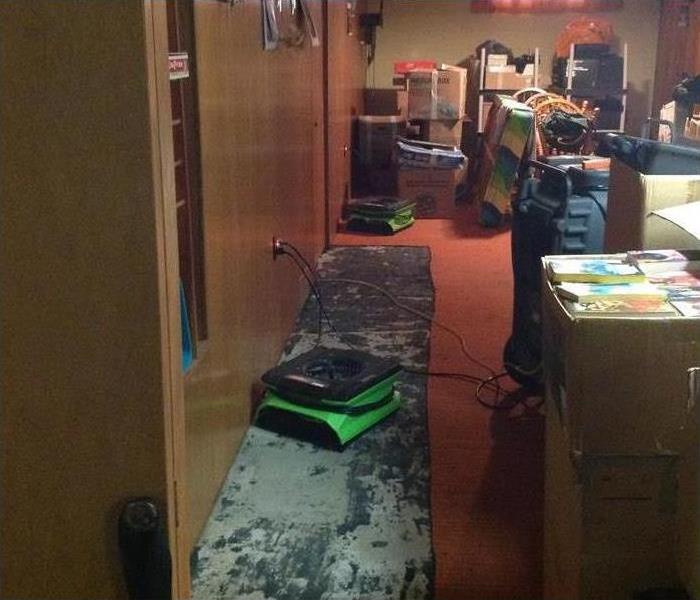 Floor drying basement floor
Floor drying basement floor
Water Restoration Process
Water removal is often considered the most important step in any water restoration process. It involves removing excess water to prevent mold growth and serious structural damage. Water removal should be done by highly trained professionals with the right equipment, experience and knowledge of the industry.
Water removal is the most important step.
Water removal is often considered the most important step in any water restoration process. It is the only way to ensure that all moisture has been removed and that mold, mildew and bacteria will not be able to grow. The best way to accomplish this task is by using specialized equipment such as:
- Water extraction tools (wet vacuums)
- Air movers (squeegees, fans)
These tools work together with dryers and dehumidifiers to remove all residual moisture from a building’s structure. These devices require expertise; therefore, it’s important for contractors who are experienced in water damage restoration services to handle these projects properly.
Equipment required for large floods and small pills.
Water removal equipment is available in a variety of sizes and shapes, from small vacuum extractors to large pumps. If you're using your own pump, be sure it has a high enough PSI rating so that it can handle the amount of water in your Oakdale, MN home or business.
If there is a large flood situation, then renting or purchasing a larger pump may be necessary. The size of the flood will dictate what kind of equipment will work best for removing it quickly and efficiently; however, paying the price to purchase or rent equipment might be more expensive than having a contractor remove the water for you.
A dehumidifier will help reduce humidity levels in your house.
A dehumidifier is a machine that removes moisture from the air. Dehumidifiers can help reduce humidity levels in your home and protect against mold growth and damage to building materials.
How Can SERVPRO of Stillwater, Oakdale, Mahtomedi help?
If you want to get back in your home as soon as possible and start the process of rebuilding, SERVPRO of Stillwater, Oakdale, Mahtomedi can help. Our technicians will work with you and your insurance company to help determine the right course of action for cleaning up and restoring your property. We also work closely with other experts in the field such as mold remediation contractors, structural engineers, and drying companies when needed.
Conclusion
Water damage can cause secondary damage if not attended quickly. We at SERVPRO of Stillwater, Oakdale, Mahtomedi understand that you have a lot on your hands and it’s hard enough to deal with the damage caused by water without having to worry about finding someone to help you with the cleanup process. That is why we are here for you 24 hours a day, 7 days a week when water damage strikes in your home or business. Our cleanup crews are fully trained in all aspects of water removal, so they know exactly what steps need to be taken before starting any type of cleanup project.
To learn more about our water damage restoration services, contact us today!
How Do You Fix a Leaky Faucet?
11/8/2022 (Permalink)
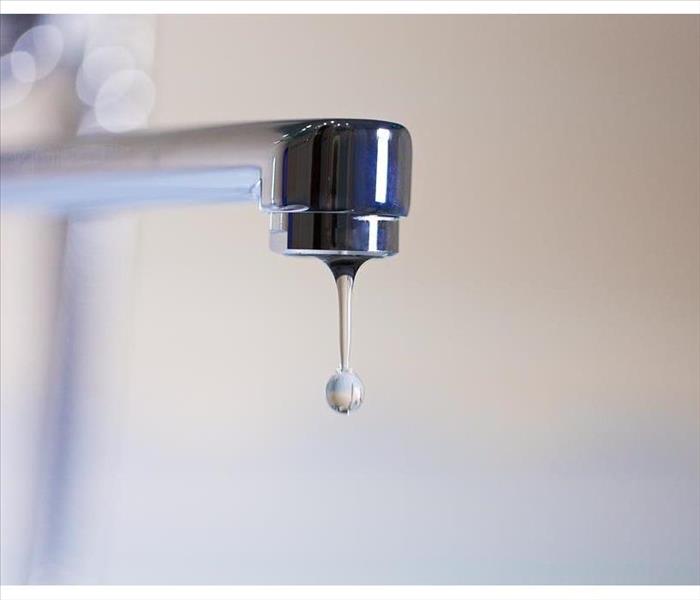 Fixing a leaking faucet is no big deal
Fixing a leaking faucet is no big deal
How Can a Leaky Faucet Be Fixed?
You’re sitting in the kitchen, enjoying a nice cup of coffee or tea, when you hear the unmistakable sound of water dripping. You turn around and see drips coming out of your faucet—ugh! You can’t do anything but sigh; it's going to be one of those days. Don't worry – with a few helpful tips, fixing a leaky faucet doesn't have to be difficult at all. Here's how.
Stop the Drip
If you are dealing with a dripping faucet, first turn the water off at the source. Then, unscrew and remove the cap from under your sink to expose the plumbing underneath. Next, remove the plastic cap that covers up where water flows through your faucet body.
Turn Off the Water
Before you begin working on the faucet, turn off the water supply valve near your water meter. This will prevent you from accidentally turning on a running faucet while working nearby and getting soaked in cold water. If you don’t know where this valve is located, ask someone who does or call a plumber for assistance.
If for some reason you are unsure how to turn off the water supply valve yourself, have no fear! It's easy enough that anyone can do it with minimal knowledge and practice.
Unscrew the Cap
If you’re going to fix your leaky faucet, use a wrench. Don’t try to unscrew the cap with your hands! You won’t be able to get a good grip and could end up dropping it into the sink or breaking it.
Make sure that you have some sort of cloth or sponge at hand (not your hands) so that if any water starts leaking out during your repair job, it doesn't get all over everything else in sight.
Remove the Plastic Cap
To remove the plastic cap, use a screwdriver to pry it off. The cap will be located under the handle of your faucet. If you're having trouble finding it, look for a small hole in the faucet body where there's likely a screw holding it in place—this should be easy enough to spot with an X-Acto knife or needle-nose pliers if you don't have any tools on hand.
Take Off the Handle Screw
1. Take the handle screw off with your screwdriver.
2. Pull off the entire handle, including all pieces attached to it (the metal part that connects to the faucet body, as well as springs and other components).
3. Replace your old handle with a new one by following instructions on its packaging.
Take Off the Handle and Remove the O-ring
To fix a leaky faucet, you'll need a screwdriver and an O-ring. First, take off the handle with your screwdriver by carefully unscrewing it from the stem. Then remove the O-ring from inside of it and replace it if necessary: if it's worn out or cracked, replace it before putting everything back together again. Make sure that you put everything back together correctly—the stem should be lined up with its notch on top when reinserted into its hole in the basin.
Take Out the Stem and Replace It
If the stem is still in place, take it out. You'll need to do this by removing the screw that holds it in place and twisting the stem off. Once you've removed the old stem, replace it with a new one by pushing it through from above and tightening its screw into place.
Clean Up Any Debris and Corrosion
You'll want to clean up any debris and corrosion. This can be done with a toothbrush, pipe cleaner, toothpick, or cotton swab.
For the threads: You'll use your brush or pipe cleaner to clean out all the debris from within them. If there is any corrosion on the inside of these threads, you should use some non-flammable mineral spirits (available at hardware stores) to remove it before reinstalling your faucet.
For the stem: Use your pipe cleaner and a small brush to wipe away any dirt or grime that may have accumulated in there over time.
In the end, fixing a leaking faucet is no big deal. It’s not something that should keep you up at night unless your apartment is on fire or something. You can save yourself some time and money by doing it yourself instead of calling in a plumber every time there’s something wrong with your plumbing. Just follow these steps carefully and you should be good to go!
3 Steps for Protecting Your Home After a Water Event
8/16/2022 (Permalink)
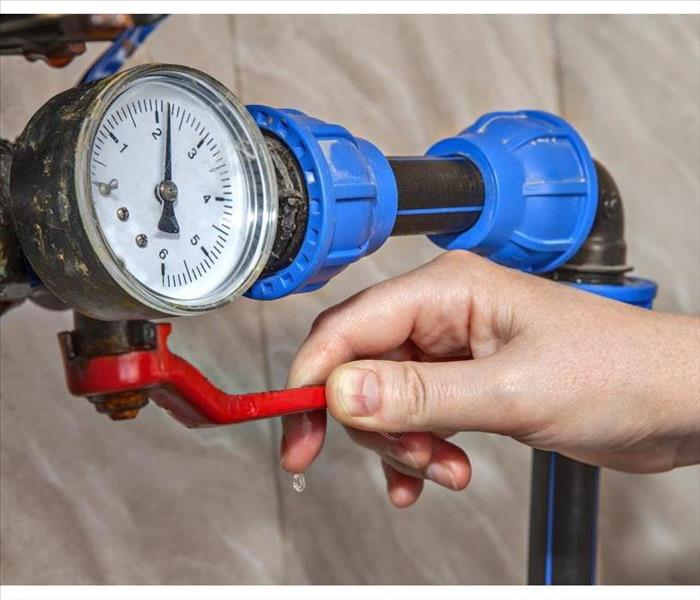 If a flood was caused by one or more pipes in your home, you should turn off your home's water.
If a flood was caused by one or more pipes in your home, you should turn off your home's water.
Three Steps to Protect Your Home After a Flood
When flooding affects your Mahtomedi, MN, home, the immediate aftermath is often difficult to handle. However, since water damage can occur quickly to your home's building materials, furniture and electronics, knowing how to prevent or reduce it can lower the risk of loss of personal or costly items.
1. Turn Off the Water Source
If the flood source is one or more broken pipes in your home, you can slow the damage by turning off your home's water. Locating the valve ahead of time and knowing how to operate it can help you act even faster, but if you are unsure of its location, check with your local water company and ask for assistance in shutting off the water supply.
2. Keep Humidity Low
Water damage can cause several secondary problems, such as mold growth, because of the increased humidity standing water tends to cause. You can slow this process by opening windows in the affected area and operating ceiling and floor fans to improve air circulation. Turning off your HVAC unit can also keep humidity levels down and prevent mold spores from traveling into other areas of the home and taking root there.
3. Remove Items To Prevent Water Damage
If the water source is sanitary, such as from a sink or broken water line, you can likely enter it to remove important items to dry them out. Remain cautious about moving through the water and if the flood's source came from an overflowing toilet or broken sewer connection, wait for a water cleanup and flood mitigation service to assist you. Water that comes from unsanitary sources may carry harmful bacteria or corrosive chemicals that could harm your skin.
Flooding can have a serious effect on your Mahtomedi, MN, home, and your belongings. Acting quickly in the wake of a flood to reduce the damage can keep repair costs low and allow for a quicker turnaround time.
How To Begin Drying Out Your Building After a Flood
3/30/2022 (Permalink)
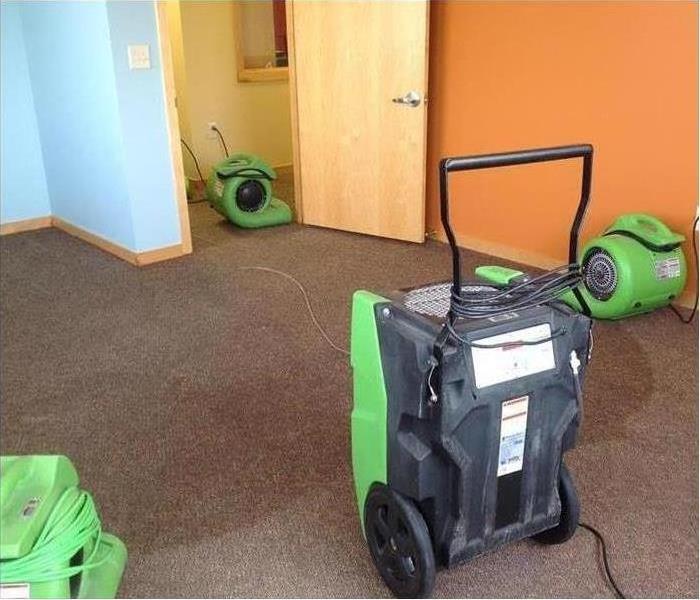 Office drying in Bay Port, MN.
Office drying in Bay Port, MN.
How To Dry Out Your Commercial Building
If your commercial building in Bay Port, MN, experiences a plumbing issue such as a pipe burst or flood, it's important to act quickly to mitigate damage. As you wait for help to arrive, there are a few things you can do to begin the clean-up process, such as beginning to dry out your building. Here are some damage tips for how to best dry out your commercial building and begin the restoration process.
Air Circulation
While you wait for help to arrive, you can begin to dry out your commercial building yourself by beginning to circulate the air and ensuring there is proper circulation in all rooms. Air circulation can be done in many ways. A few ideas are:
- Opening all doors and windows to let outside air in
- Using oscillating fans around your building to get air moving
- Using high-speed air movers
Air circulation can be used to dry out your commercial building. This works by speeding up moisture evaporation, but isn't effective for spot-drying any excessively wet areas. However, air circulation will begin to dry ceilings, walls and furniture.
Dehumidifying
Another one of the essential damage tips you can use as you wait for a damage restoration company to come is to dehumidify the area. A dehumidifier can be used to reduce humidity and moisture, while will help dry out the area. Dehumidifiers work best for places where you cannot get proper air circulation from outside, such as basements or other enclosed rooms. Be sure to follow all instructions for your dehumidifier, such as shutting all windows and doors and changing the water periodically for dehumidifiers that do not self-drain.
Using a Wet-Dry Vacuum
There are also cleaning tips for spot-drying excessively wet areas. The best way to do this is to use a wet-dry vacuum or shop vac. These work best on small areas such as carpets. You can rent a shop vac from an equipment rental company. If you call in a professional restoration company may bring their own.
You can use these water damage tips to help kickstart the restoration process for your commercial building.
4 Surprising Water Damage Tips
2/26/2022 (Permalink)
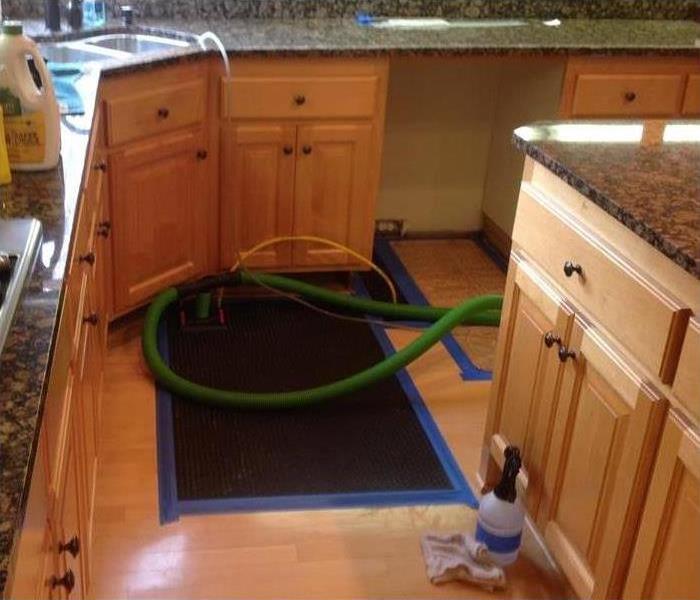 Water damage restoration services in Oakdale, MN.
Water damage restoration services in Oakdale, MN.
Water Cleanup Tips
Water damage in Oakdale, MN, can occur at any time, and it often happens with little to no warning. Whether the cause stems from broken pipes, backed-up toilets or hidden leaks, damage from unwanted water in your home can be devastating. Fortunately, there are some things you can do to clean up the mess and restore your home after a water catastrophe. Here are four surprising water cleanup tips you should try the next time you experience unwanted water in your home.
1. Start Cleaning Immediately
It usually takes a little while for permanent damage from water to set in. That’s why it’s so important to immediately begin cleanup efforts once you notice a leak or spill. Allowing water to sit for long periods of time can also lead to mold growth and may require the help of professionals to remove. Mops, towels and fans can all be used to clean up excess water and dry the area while you wait for professional help to arrive.
2. Move Valuables
If a leak occurs near valuable items such as furniture or expensive rugs, move them immediately. Even if you have to take them outdoors temporarily, it’s better to do that than to allow the water to soak into your valuables and ruin them.
3. Place Wood Blocks Under Furniture Legs
If you don’t have the time or the resources to move heavy furniture by yourself, prop them up off the floor with wooden blocks if possible. That way, shallow water won’t be able to reach them and cause permanent water damage.
4. Wear Protective Gear
You don’t know what kinds of bacteria might be lurking in water from backed-up or broken pipes. To protect yourself, wear safety gear such as thick gloves, masks and special rubber footwear.
While it’s always best to let professionals take care of water damage, you don’t have to sit idly by while you wait for them to arrive. Instead, try minimizing damage by implementing one or more of the above water cleanup tips.
Keep Your Vacation Flood Free
1/31/2022 (Permalink)
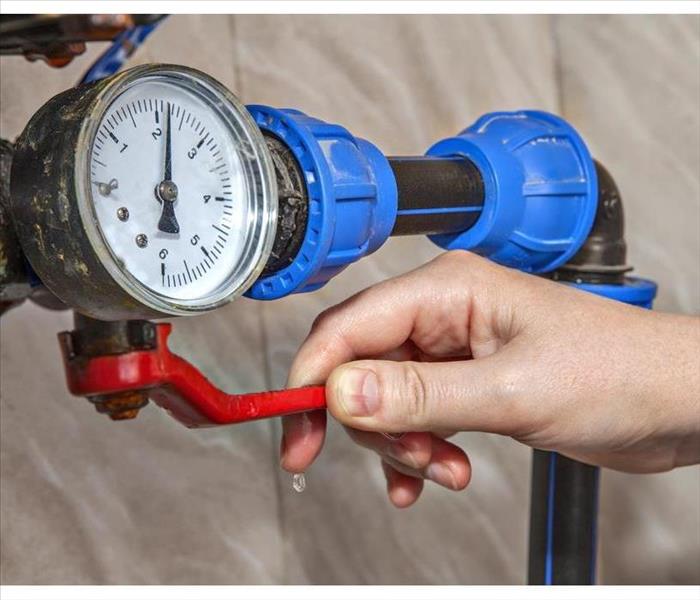 Turn off your water entirely.
Turn off your water entirely.
Here Is How To Keep Your Home Dry
So, you’re ready for your next vacation. You have the trip booked and your itinerary ready, but there’s still one thing you need to do: Make sure that a broken pipe doesn’t ruin your vacation. If your home floods while you’re gone, the damage can be extensive. Here is how to keep your home dry.
1. Repair Pipes
Are your pipes in working order? Even if you think that maintenance of your pipes is up-to-date, it’s always smart to make sure. Don’t slack on pipe repair. While you’re on vacation, you need to have peace of mind that your pipes aren’t at risk of bursting while you’re away from your Afton, MN, home. Investing in water pipe repair in advance can save you the headache.
2. Turn the Water Off
If you’re worried about flooding from a broken pipe while you’re away, you can also take an easy step that most vacationers should: Turn off your water entirely. This will save you from having to return home to a flooded residence.
3. Check Supply Lines
Your next order of business should be to check the supply lines. Water pipe repair may fix a lot of your problems, but if the supply lines are ruptured or malfunctioning, then you may have a flood on your hands. Make sure that the lines are properly installed and not leaking.
4. Test Sump Pump
Your sump pump helps keep water out of your basement. Often, this is ground water that could leave you with a flooded downstairs. Before you leave on your trip, make sure that the sump pump is still in working order. You can do this by filling it up and making sure that it ejects properly.
No one wants to deal with water damage. If your home is flooded while you are away, you won’t be able to get a restoration specialist in quickly. This is why it’s important to prevent flooding by taking water pipe repair seriously, shutting off the water, checking your supply lines, and testing your sump pump.
What Homeowners Insurance Means For Broken Pipes
12/31/2021 (Permalink)
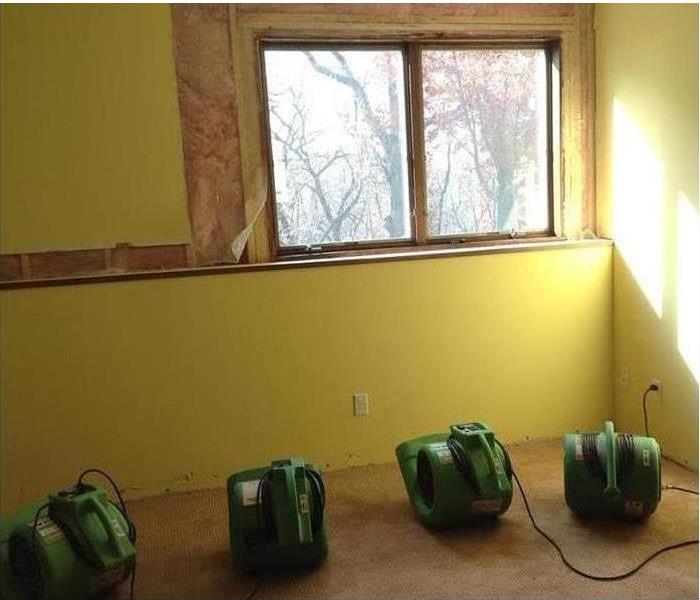 Drying process in a Lakeland, MN home after water damage.
Drying process in a Lakeland, MN home after water damage.
What Homeowners Insurance Means For Broken Pipes
A bursting pipe leads to a flood of water and costs. Insurance will reduce the costs once the claim goes through. Understanding the process is essential to know what to expect from homeowners insurance when your home has an unexpected pipe issue.
Determining Fault
First, insurance companies will send an inspector to your home to evaluate the circumstances of the claim. They will evaluate if the break was unexpected and unpreventable. They consider several situations homeowner negligence:
- An unthawed frozen pipe bursting when a heater could’ve been used
- Ignoring a long-term leak
- Tampering with the pipe and breaking it
- Not attending to aging or rusting pipes with regular home maintenance
It’s the burden of the insurance company to prove fault. Insurance will only cover what’s needed to fix broken pipe if the damage is unmistakably an accident.
What Is Covered
Once the policy holder is cleared of any fault, the insurance coverage deploys. Most policies will cover every cleanup and repair service necessary up to the policy’s monetary limit.
There are additional parts of an insurance policy that may be applicable to you. Dwelling coverage is offered to make sure your home is structurally sound by covering the repair of pivotal parts of your home such as walls, roofs and floors. Property coverage insures your belongings up to a limit if they are damaged or lost in a flood. Lastly, additional living expenses coverage pays for a hotel and accommodations if you are not allowed to reside in your home during restoration.
The Process
The pipe will be repaired by a plumbing professional arranged by the insurance. The secondary water damage from the burst or leak will be handled by an expert water damage cleanup crew. Drywall, carpet and paint restoration are included in these services.
A broken pipe doesn’t have to mean going broke fixing your home. An unforeseen flood in Lakeland, MN, is easily remedied by using and understanding your insurance.
Keeping Your Basement Dry
11/22/2021 (Permalink)
 Water event in a basement.
Water event in a basement.
During the wet months of the year, we run across homes that have had multiple water events in the basement over the years. These homeowners have redone landscaping, put up new gutters and downspouts and, still have water, in the basement. What else can a homeowner do? The can look into drain tile options:
What is Drain Tile?
Chances are if your home has a basement and has experienced flooding, someone has told you to get drain tile. But what is drain tile and how does it help?
Essentially drain tile is a way to protect your home from groundwater flooding. It redirects water away from your home before it can enter and cause damage. It is one of those things you never need – until you do! Increased run off from urban expansion and more frequent severe weather systems make our homes more likely to flood. Investing in a drain tile system could save you from lengthy insurance claims and expensive cleanups in the future.
How Drain Tile Works
Despite its name, drain tile is actually not tile at all. When used in the construction industry it actually refers to drainage piping. Drain tile is a system of subterranean drainage laid around the footings of a building. Water always chooses the path of least resistance so drain tile offers the easiest path. The pipe used for drain tile is porous so water finds its way into the pipe system rather than your home. Water is then directed away from your home using gravity or an electric sump pump. Once in the pipe the system directs the water to a dry well or releases it above ground to run off into a storm drain or sewage system.
What To Do When Your House Floods
5/28/2021 (Permalink)
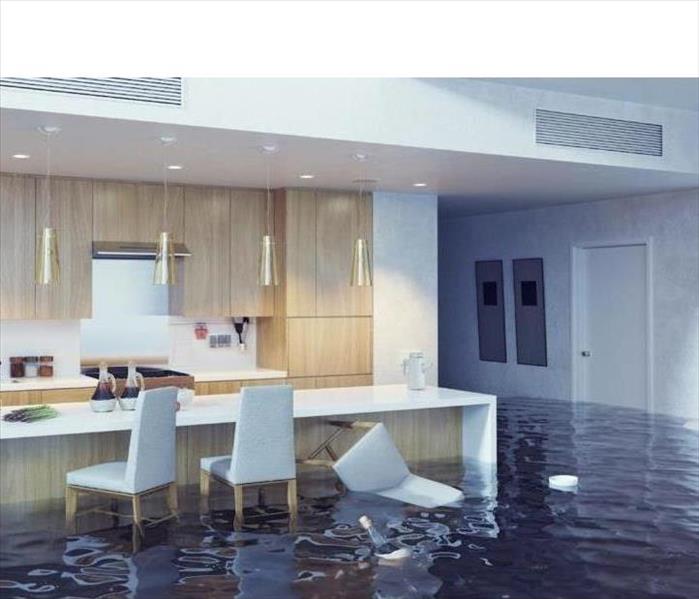 98% of basements in houses in the US are prone to flooding and will experience water damage during their lifespan.
98% of basements in houses in the US are prone to flooding and will experience water damage during their lifespan.
Flooding is a major problem for many residents in the US. Water Damage Defense states that about 98% of basements in houses in the US are prone to flooding and will experience water damage during their lifespan. And when it comes to house floods, no matter how minor it is, it can be damaging and can leave your home vulnerable to damage and mold growth.
Whether the flooding is caused by heavy rain, sewer back-up, or a broken pipe, it is crucial to deal with the flood as soon as possible to prevent further water damage. Here are the first things that you need to do when faced with house floods.
Floodwater poses a lot of risks both to your safety and health. The electricity that has come in contact with water can be life-threatening. Make sure to turn off the main breaker and all other individual fuses in your home before you step into the floodwater. If the water is too high, call a licensed electrician to inspect and evaluate your power box condition. Don’t forget to wear protective gear too, such as gloves, boots, and a mask. You don’t know what contaminates the water; it is best to protect yourself against the harmful chemicals present.
If you have kids at home, make sure to refrain your children from eating the foods that may have come in contact with water for an extended period. Transfer furniture and other items that can still be salvaged in a higher area.
- Identify the source of the flood and stop it.
Once the main power supply is turned off, the next thing that you will need to do is to find the cause of flooding and prevent more water from coming into your home. This will help prevent further water damage to your house. If the cause of a house flood is a leaky or broken pipe, then turn off your home’s main water supply.
Before you start removing the floodwater to clean up your home, take a video or pictures of everything affected by the water. Documenting the damage done by the flooding is crucial for your insurance claims. Take photos of the damaged items, the warped wall and flooring, and other water damage in your home. Then keep a copy of every single document that you have presented to your insurance agent.
- Call your insurance provider.
Once all the necessary documents are ready, call your insurance provider and inform them about the incident. Your insurance company will then send an adjuster to inspect the damage and evaluate the losses.
- Get help from a reputable water damage professional.
You may be tempted to do the water removal and cleaning process on your own. However, time is of the essence when it comes to water damage. The earlier and the faster you deal with the flood, the lesser damage it will cause. The best way to deal with water damage caused by house floods is by calling a reputable water restoration company like Water Damage America. The good thing about hiring professional water restoration contractors is that they can also assist you with your insurance claims.
Not So Pleasant Home Away from Home
3/12/2021 (Permalink)
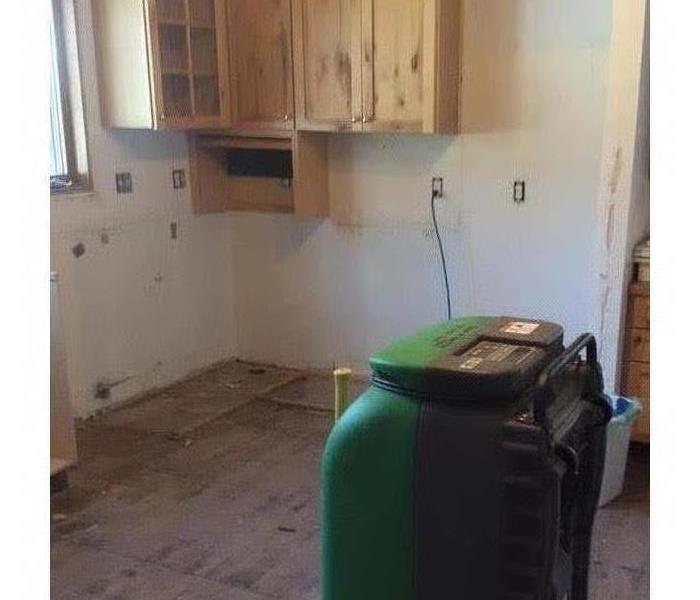 What do you do? You are far from home, and don’t really know the area.
What do you do? You are far from home, and don’t really know the area.
For most people that are fortunate enough to own a cabin up north, or a second vacation home, the thought of getting away is filled with thoughts of unplugging, relaxing and family time. Unfortunately, that wasn’t the case for one of our recent clients. When they arrived at their second property to enjoy a few days of quiet, they opened a door to a home full of water damage and mold.
What do you do? You are far from home, and don’t really know the area. Luckily for these clients we had been in the area a few months prior, and their neighbor we worked for gave our number to them. We were able to coordinate with their insurance adjuster, and work out the cause of the damage and scope of the project. It was discovered after we brought in a local HVAC provider that the heating core on the furnace had cracked, causing the temperature inside the house to drop, and allowed the water line to freeze and burst.
Before we could stabilize the environment in the home, we needed to get heat back into it. That is where we helped the client coordinate with the HVAC company to bring in and install a new furnace. Once in, we were able to stabilize the climate and coordinate with a mold testing vendor to determine the appropriate course of action to mitigate the mold. Once the area was properly cleaned, including cleaning the duct system, and damaged areas removed a contractor was able to come in and start the rebuild.
Follow These Tips to Prevent Spring Thaw Flooding
2/26/2021 (Permalink)
Spring is notorious for its unpredictable weather. The combination of heavy rains and rapid snow thaw can result in severe home flooding. Here are vital tips to prepare your home for spring thaw and prevent water damage:
- Remove snow around your house with a shovel so that thawed snow will drain away from your home. Also, remove obstructions or debris that could prevent water from being carried away from your house.
- Check your home’s drainage. Ensure that flood drains outside your house are not obstructed by debris. Check that the floor drains in your home are unobstructed as well. Roof drains should be open and flow freely.
- Maintain gutters and downspouts. Backed up gutters and downspouts are likely to cause overflows and flooding. Remove debris, ice, and snow from gutters and downspouts so water can freely move away from your home.
- Have your roof inspected to ensure that it is prepared for storms and to keep water out of your house.
- Install water alarm and flood sensors if your home is prone to flooding. These devices are designed to send an alert when they detect unwanted water in the home.
- Elevate items in the basement. Relocate sensitive items, such as documents or electronics to the upper levels of your home. If you can’t move items from the basement, move them off the ground and onto shelves or pallets.
- Install a sump pump in the basement. Sump pumps protect your basement from flooding by removing excess water around your home’s foundation, transporting it safely outside. If you already have a sump pump, make sure it is clean and the intake valve is clear. Test the sump pump to ensure it’s in proper condition.
- Purchase flood insurance ahead of time. Most homeowners’ policies do not include flood damage so it’s important to purchase this protection separately.
Oh Boy, My Pipes Froze This Winter
2/10/2021 (Permalink)
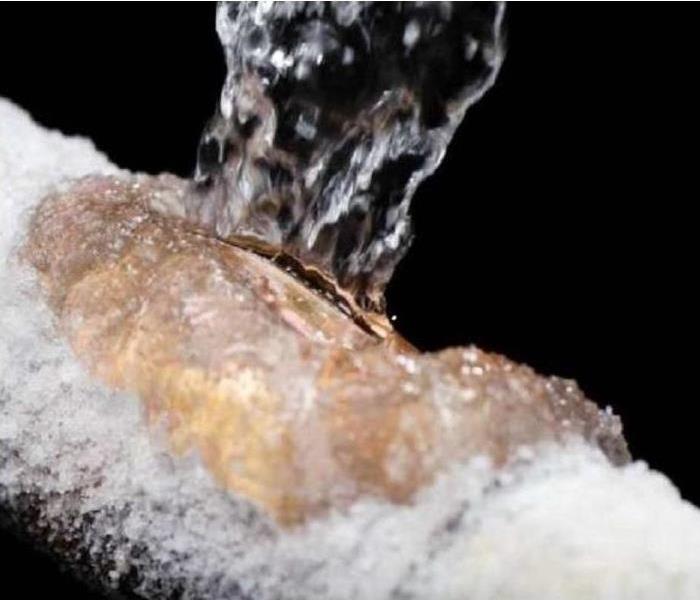 Don't Wait For Spring Surprises.
Don't Wait For Spring Surprises.
You’ve made it to the end of another winter of cold long nights. You didn’t have to call out SERVPRO because you took care of the snow on your roof and stopped the ice dam build up. You kept the heat in the house above 55 degrees all winter and turned off your water when you went on that tropical vacation in January.
It’s time to start the clean up the spring and summer seasons. You hook up your hose to your pressure washer to clean the winter grime off your gutters and eaves. Pull the trigger on the pressure washer and, nothing happens. That’s when you realize that you don’t have any water pressure, but where is the water going.
You turn off the outside facet and run downstairs, to find that water has been running into you finished man cave basement. The one thing you didn’t check was the pipe running to that outside facet, and you may have forgotten to open the facet to run the rest of the water out of it when you shut the source off. It’s pretty common and we aren’t surprised that it happened, we get quite a few calls at SERVPRO in the spring in early summer about this exact same thing.
Please follow our page, as we continue to explore the benefits of mitigation, and how this approach helps both your clients and your business. Please call us with any questions you have, 651-705-7028. Visit our site: SERVPRO of Stillwater, Oakdale, & Mahtomedi
Soon It Will Be the Melting Season
2/10/2021 (Permalink)
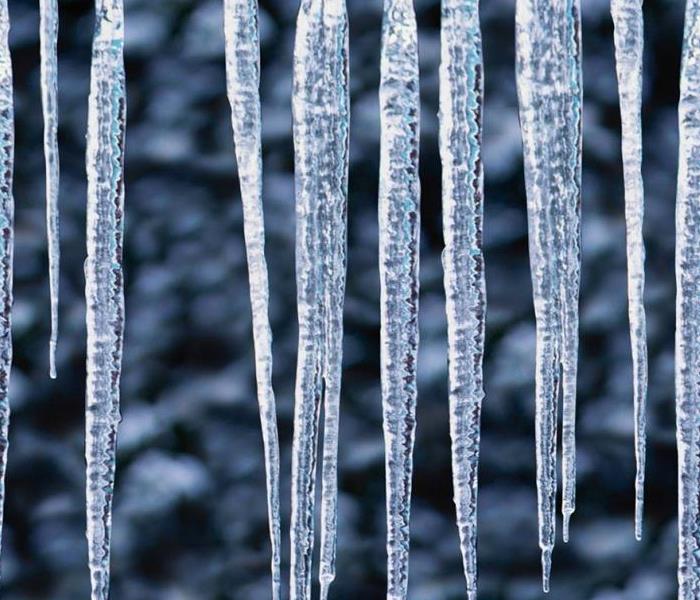 Soon Seasons Will Change
Soon Seasons Will Change
Though it may not feel like it right now, soon seasons will change and we are reminded of the approach of spring, and with that, winter run off. What have you done to prepare your home for the winter melt? If you remember a few years ago in the Saint Croix Valley region, the spring brought rivers running over their banks, parking lots flooding, businesses, schools and home basements filling with water. Now with that year’s crazy weather, there wasn’t much you could do to combat the flooding. On a more manageable year like the winter we’ve had, there are a few things you can do.
First, way back in the fall you should have clear your gutters on the roof out one more time, once the leaves were off the trees. This allows for the roof snow to melt off and drain properly, avoiding water running over the sides and pooling next to your house’s foundation. Throughout the winter it’s a good idea to rake the snow off your roof as well, this will help avoid ice dams on your roof. This will also help with the flow of water once the roof snow starts to melt.
Around the foundation of your house, you will want to shovel the snow away and make sure that melting snow flows away from your home. If you do all of this, and mother nature still decides to not play nice, SERVPRO of The Saint Croix Valley will be here to help, make it like it never even happened.
Please follow our page, as we continue to explore the benefits of mitigation, and how this approach helps both your clients and your business. Please call us with any questions you have, 651-705-7028. Visit our site: SERVPRO of Stillwater, Oakdale, & Mahtomedi
3 Top Causes of Winter Water Damage
2/10/2021 (Permalink)
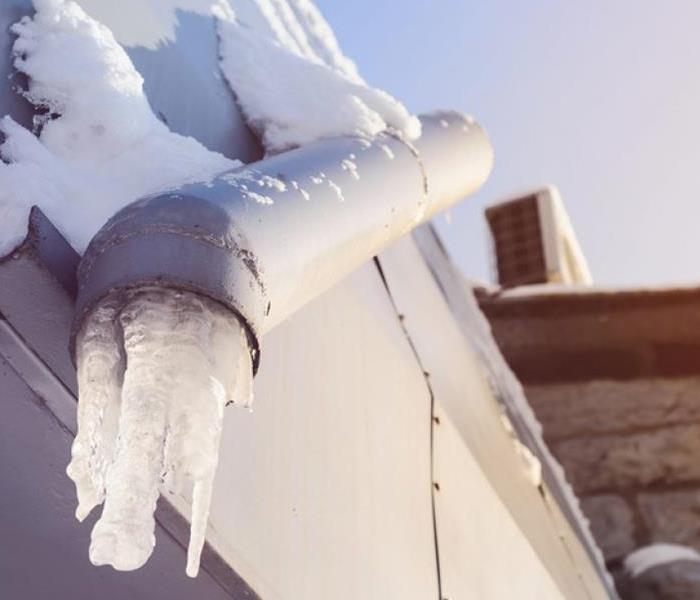 Residential Homes Are Especially Vulnerable to Water Damage
Residential Homes Are Especially Vulnerable to Water Damage
Winter brings along with its chilling temps a host of water damage possibilities. Residential homes are especially vulnerable to water damage during the winter season. Three main types of winter water damage are common when the weather is below freezing. Burst pipes are one of the top sources of water damage that can be prevented. Roof leaks are an enormous burden, which, again, with proper attention, can be stopped before transforming into an expensive repair. Outdoor water sources can also be a likely source of winter water damage when left unattended.
Burst Pipes Are Commonplace
Pipes, whether plastic or metal, are notorious for bursting in subfreezing temps. Contrary to popular assumption, pipes rarely burst due to expanding ice contained within them. Rather, pipes break due to the buildup of water pressure between a sink’s faucet and an ice blockage. No matter how sturdy a pipe may be, it’s no match for expanding water. The pipe will rupture.
Typically, the pipes that are especially prone to breakage are uninsulated ones that are located along the exterior walls and water pipes that run along unheated areas of a home, like the attic, basement, garage, crawl space or underneath a kitchen sink.
Insulation is the number one protection against a burst pipe. Prior to winter, inspect all areas of your home that contain unheated water supply lines. Pipe sleeves can easily be purchased and fitted to the pipes in the garage, under the sink and beneath the bathroom cabinets. If pipe sleeves are unavailable, experts recommend using a quarter-inch of newspaper to surround the pipes, which offers an equally effective solution against the damage caused by sustained freezing temperatures.
Maintain a cozy indoor temperature to prevent frozen pipes. Especially when you are away, run the heat continuously at no less than 55 degrees Fahrenheit. Experts also suggest maintaining a consistent temperature throughout the home. (This is costlier than turning down the heat at night, but it may prevent an even more expensive broken pipe fix.) Another tried and true method to prevent a split in your water pipe is to let the faucet trickle small amounts of water. Dripping even the tiniest volume of water during subfreezing temperatures allows the water to run through the pipe without freezing. Unheated compartments of a home can also benefit from warm air. A winter weather defense strategy like this can be achieved by leaving open the kitchen cupboards and bathroom cabinets to allow warm air to circulate around the pipes. Lastly, keep garage doors closed if water lines run through them.
When water pipes are frozen, they can be thawed. Apply a towel soaked in hot water around the frozen pipes to gently thaw the freeze. An electrical heating pad will do the trick, just as well. Also, keep the faucet running, which allows the flowing water to gradually melt the ice.
Prevent Gutter Blocks to Protect Your Roof
Gutters are invaluable in directing running water away from your home. When gutters freeze, however, or are blocked by ice, they can end up being rather destructive. A home’s gutter system can get weighed down by ice buildups. When the snow along the roof melts from heat that escapes from inside the home and trickles into the gutter, it pools and freezes into what is known as an ice dam. Snow that melts from the home’s internal heat is a key indication that there is a lack of proper insulation.
Ice dams along the gutter put unnecessary stresses on a roof. Water can infiltrate underneath the roof shingles, lifting them up and causing roof damage. Roof leaks are the result. Once a leak happens, you may find unsightly water marks along your home’s ceilings or drips that cascade into your home’s interior—both causes for concern.
When you detect a faulty shingle, take immediate action to replace it, especially prior to the winter season. It’s more cost effective to replace worn shingles as you find them, rather than replacing an entire roof.
Observing your home’s gutters and grading during dry or rainy weather and before winter helps to ensure your roof is properly prepped for winter.
Outside Water Sources Can Spell Disaster
When the first snowflakes fall, it’s far easier to enjoy its splendor than it is to remember what’s left on the ground underneath the snow. Outside water sources can be irksome when subject to subfreezing weather.
Be sure to remove all outdoor hoses from the yard. Drain them and store the dry hoses inside. Plus, shut off valves that supply water to the outdoors. All hose bibs should be opened to allow any remaining water to drain. Experts suggest leaving the outside valve open so that any excess water has enough room to expand without breaking the pipes.
When a water pipe in your home’s plumbing system unexpectedly bursts, surges of water end up penetrating the surrounding areas at breakneck speeds. As a homeowner, you’re left with puddles of water and the likelihood of mold infestations to clean up. Or, perhaps a roof has finally given in during the dead of winter, resulting in drips of water that causes property ruin within minutes.
Water Damage Restoration
Despite all preventive measures, disasters tend to occur. When an emergency happens, contact a professional water damage restoration company, like SERVPRO. Specialists from companies like ours are well-equipped to drain all excess moisture from homes and businesses in substantially less time than a standard dehumidifier. It is crucial to remove standing water immediately, due to the growth of mold and bacteria that occurs within hours.
Water damage restoration technicians use advanced meters to detect the level of water damage. Air movers and other high-tech equipment are used to thoroughly dry out the affected areas.
Our specialists will quickly return your home to its pre-damaged condition.
Please follow our page, as we continue to explore the benefits of mitigation, and how this approach helps both your clients and your business. Please call us with any questions you have, 651-705-7028. Visit our site: SERVPRO of Stillwater, Oakdale, & Mahtomedi
Ice Dam Prevention
1/19/2021 (Permalink)
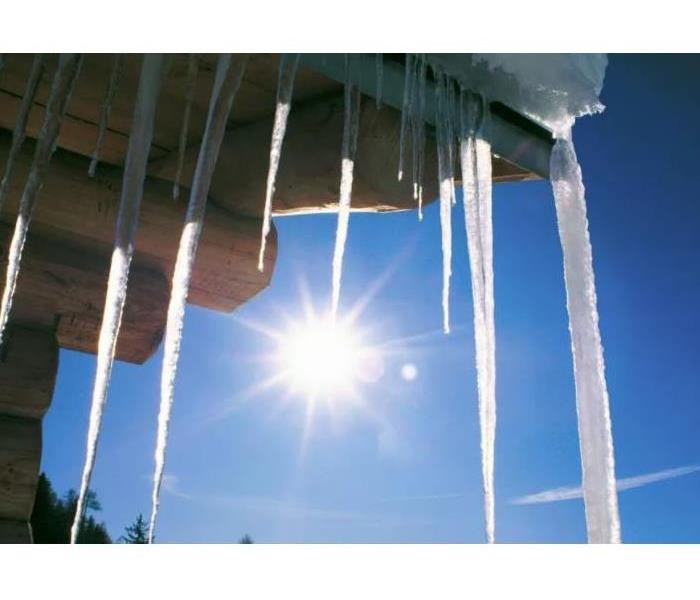 Stopping ice dams is simple, in principle.
Stopping ice dams is simple, in principle.
Here’s how to prevent ice dams in 8 steps so you can enjoy a winter free of icicles and the damage they can do to your roof.
Dam Busters
Stopping ice dams is simple, in principle: Just keep the entire roof the same temperature as the eaves. You do that by increasing ventilation, adding insulation, and sealing off every possible air leak that might warm the underside of the roof, as shown in the illustration below. By taking care of these trouble spots, listed here in order of priority, you should enjoy a winter free of dams and use less energy to boot.
- Ventilate Eaves and Ridge
A ridge vent paired with continuous soffit vents circulates cold air under the entire roof. Both ridge and soffit vents should have the same size openings and provide at least 1 square foot of opening for every 300 square feet of attic floor. Place baffles at the eaves to maintain a clear path for the airflow from the soffit vents.
- Cap the Hatch
An unsealed attic hatch or whole-house fan is a massive opening for heat to escape. Cover them with weather-stripped caps made from foil-faced foam board held together with aluminum tape.
- Exhaust to the Outside
Make sure that the ducts connected to the kitchen, bathroom, and dryer vents all lead outdoors through either the roof or walls, but never through the soffit.
- Add Insulation
More insulation on the attic floor keeps the heat where it belongs. To find how much insulation your attic needs, check with your local building department.
- Install Sealed Can Lights
Old-style recessed lights give off great plumes of heat and can't be insulated without creating a fire hazard. Replace them with sealed "IC" fixtures, which can be covered with insulation.
- Flash Around Chimneys
Bridge the gap between chimney and house framing with L-shaped steel flashing held in place with unbroken beads of a fire-stop sealant. Using canned spray foam or insulation isn't fire safe.
- Seal and Insulate Ducts
Spread fiber-reinforced mastic on the joints of HVAC ducts and exhaust ducts. Cover them entirely with R-5 or R-6 foil-faced fiberglass.
- Caulk Penetrations
Seal around electrical cables and vent pipes with a fire-stop sealant. Also, look for any spots where light shines up from below or the insulation is stained black by the dirt from passing air.
Everything you need to know about frozen pipes.
12/17/2020 (Permalink)
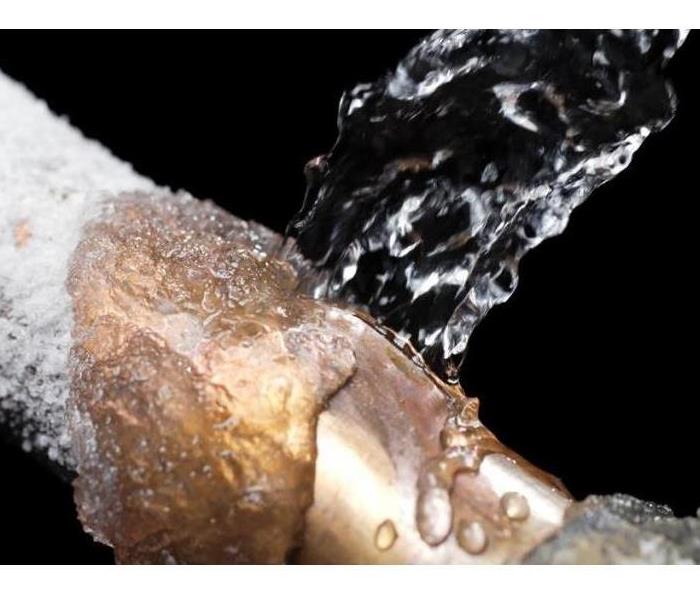 If you live in an area of the country that gets cold winters, one of those things that can go wrong is a frozen pipe that bursts.
If you live in an area of the country that gets cold winters, one of those things that can go wrong is a frozen pipe that bursts.
As a homeowner, you have a list of maintenance items and things that can go wrong in your home. If you live in an area of the country that gets cold winters, one of those things that can go wrong is a frozen pipe that bursts. Burst pipes can cause massive water damage in your home and become a very expensive mess to clean up. You need more information to keep your pipes from bursting.
What causes a water pipe to burst?
Of course, there is more than one reason that a water pipe in your home can burst. It's beneficial to be aware of the various causes of pipes bursting, including:
- Corrosion: If your pipes are made from metal, over the years, they begin to rust and weaken. This weakness can cause your pipe to burst.
- High water pressure: Your pipes can burst if the water pressure is too high. According to Energy.gov, your water pressure shouldn't exceed 60 pounds of pressure per square inch (PSI).
- Tree roots: As the pipes wind through your yard to the house, tree roots may grow into them, and this causes the pipes to burst.
- Shifting soil: If construction is going on around your home, it's possible for the soil to shift and your water pipes to burst.
- Clogs: Excess toilet paper and hair can create clogs in your pipe, and if these clogs get large enough, it can cause the pipe to burst.
- Freezing temperatures: When the temperatures dip low enough, the water in your pipes can freeze. As ice builds up in a single location, it applies pressure to the pipe, leaving it vulnerable to bursting.
After learning the common cause of burst water pipes, you can take steps to avoid problems. You don't want the expense and aggravation of dealing with a burst pipe.
At what temperatures do pipes freeze?
Is it enough that the temperature outside is freezing for my pipes to freeze? No, not really.
You need to remember that both the ground and the material of the pipe need to freeze before the water inside it will freeze. You need a few days and possibly weeks of freezing weather before the water inside freezes. In order for the water inside your pipe to freeze overnight the outside temperature needs to reach 20 degrees Fahrenheit. While you can't do anything about freezing temperatures, there are things that you can do to protect your pipes.
How can you protect your pipes from freezing and bursting?
You don't want to deal with the mess and expense that come from a burst pipe, no matter the cause. Fortunately for burst pipes due to freezing, there are some steps you can take to prevent them from freezing and to prevent them from bursting if they've become frozen. Here are some tips to avoid frozen pipes, including:
Leave the water on at a drip: While moving water can freeze, it's much less likely that water in your pipes will freeze if it's moving. It's beneficial when you hear that your area is experiencing or expected to experience a deep freeze that you turn on each of your faucets to a drip. It doesn't need to be a heavy flow. A slow drip is enough, and it shouldn't affect your water bill too drastically. It's certainly cheaper than replacing pipes, and the cost of repairs due to water damage.
- Keep your garage doors shut: If you have water pipes that wind their way through the garage, you want to keep the doors shut to keep the temperatures inside the garage warmer, and hopefully, above freezing.
- Open cabinet doors; You need to open the cabinet doors below any sinks or other water sources in your home. By opening the cabinet doors, you allow the warmed air in your home to reach part of the pipes inside the home. This keeps the pipes warmers so that they don't freeze.
- Maintain a constant temperature: Many people lower the temperature in their homes at night during the winter months to sleep more comfortably and to save money on utility bills. However, to protect your pipes, it's better to pay a little more on your utility bills and protect your pipes by not allowing your home to become too cool at night.
- Add insulation: To keep your attic, basement and crawl spaces warmer during hard freezes, add insulation to these areas. These are places where pipes are apt to freeze and burst due to the colder temperatures in these areas.
- Remove hoses: If you have hoses attached to your home, remove and store them during the winter months. It's also a good idea to shut off the water running to the outdoor faucets while leaving them in an open position. The remaining water will flow out of the pipes.
If you've done all of this, and you still suspect that you have a frozen pipe, you can still keep the pipe from bursting. Follow these tips:
- Turn the faucet on to a drip: If you suspect that you have a frozen pipe, you need to turn it on to a drip. As you attempt to melt the ice blocking the pipe, running helps the ice to melt faster. However, you don't want to turn the faucet on full, because the pressure of the water behind the pipe might cause it to burst.
- Apply heat to the blocked area: If you can locate the area of the pipe that has the frozen blockage, you can apply heat with a hairdryer, heating pad, a space heater or some other non-flammable source. This will melt the ice inside and allow the water to flow freely again.
- Call a professional: When you can't find the frozen section or it's behind a wall or under the floor, it's time to call a professional.
Among other things, cold weather can cause a water pipe in your home to burst. However, the outside temperatures must reach around 20 degrees Fahrenheit and below for this to happen. By following our tips, you can avoid frozen pipes and pipes bursting due to freezing temperatures.
Honey, We Have a Pool In the Basement
7/8/2020 (Permalink)
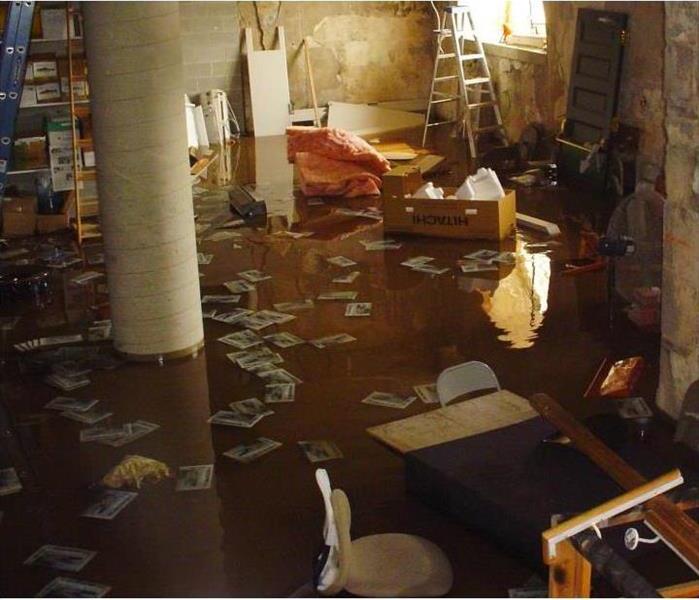 A little maintenance in and around your home might save you from a view like this.
A little maintenance in and around your home might save you from a view like this.
With the recent storm, our office has had quite a few calls about standing water in homeowners’ basements. Once the water has been mitigated, the next question we get asked is how to stop this from happening again. For this question, we can give you some suggestions to think about.
You constantly keep your gutters cleaned out, and everything unplugged, but your gutters still overflow in a heavy rain. Maybe the size of gutter you have is too small for the amount of rain that comes off your roof. If you have a 3 or 4 inch gutter system, look at installing a 5-7 inch gutter to accommodate the volume of rain. Is your problem standing water around your foundation? You may need to address your landscaping, making sure that your yard slopes away from your foundation. If your yard is properly sloped and you still have excess water sitting in your yard a French drain may help with this. Finally if your problem is seepage into your basement from a high sitting water table, a tile drain system with sump pump may be the answer. Typically you would want to discuss any of these solutions with an expert to have them properly installed.
Please follow our page, as we continue to explore the benefits of mitigation, and how this approach helps both your clients and your business. Please call us with any questions you have, 651-705-7028. Visit our site: SERVPRO of Stillwater, Oakdale & Mahtomedi
Rain Rain Go Away
6/17/2020 (Permalink)
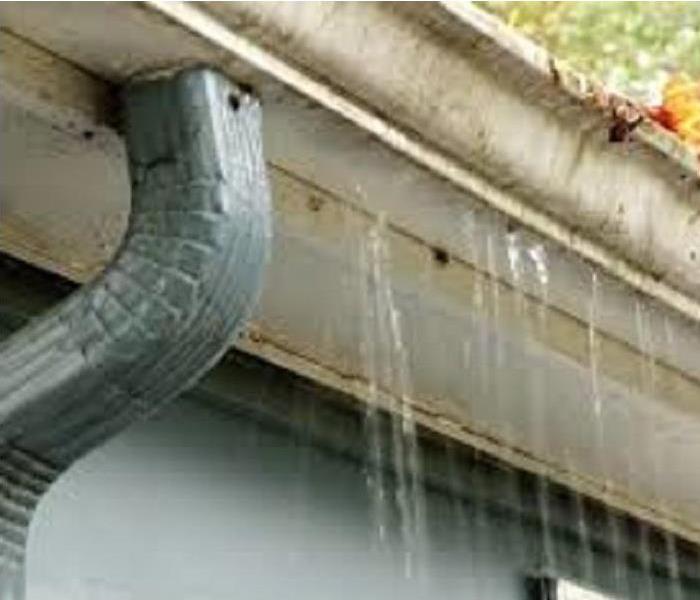 It’s a good idea to keep up with your home maintenance.
It’s a good idea to keep up with your home maintenance.
During the winter months we talk a lot about watching your roof and gutters for ice buildup, to help avoid ice dams. Today we are going to talk about your house gutters again, but only with a non winter slant. It may not be fall yet, but debris from trees still falls on your roof, the usual leaves or sticks on a winter day, or the really messy dried pine needles. All of which can plug your gutters and cause rain run off to flow over the edge and collect around your foundation.
We suggest that you periodically check your gutters and remove the buildup. Especially when the weather man is predicting a heavy rain fall. If the water over flows and lands around your foundation causing an excessive saturation, which can seep into your basement and cause damage. The good news is, SERVPRO can help with the mitigation. The bad news, homeowners insurance doesn’t always cover for seepage of this sort in most policies. That’s why it’s a good idea to keep up with your home maintenance to avoid having to call us out.
Please follow our page, as we continue to explore the benefits of mitigation, and how this approach helps both your clients and your business. Please call us with any questions you have, 651-705-7028.
Breaking Through The Panic When You Need Water Damage Restoration
4/13/2020 (Permalink)
You were just relaxing at home when all of a sudden, there was a loud clunk and then a rushing sound as water began to pour into your basement. Maybe the rains came and didn’t stop for so long that the ground became saturated and water seeped into your living room. It could have been an unnoticed leak behind the walls, or even improperly sealed doors. But whatever the cause of unwanted moisture in your home, the result is the same – water damage that destroys property and creates a breeding ground for all sorts of nasty stuff.
When this happens, we feel panic because the water needs to be stopped and removed as quickly as possible to minimize the damage. The longer it sits around – or worse, continues to flow – the more significant the health hazards.
We know it’s an insane time, but we’re here to help guide you through the process, from important first steps to finding and engaging excellent water damage restoration services. Take a deep breath, center yourself, and then get started. The following steps will prepare you to safely address water damage in your home.
Stop or contain the flow of water if possible
If the cause is a burst pipe, locate the main water valve and turn it off. This is also helpful if you have a leaky pipe that is merely dripping, but if it is in an accessible area, you can choose to catch the drops in a bucket rather than cut off water to the entire home. If you’ve had a flood, discover where most of the water is entering and try to divert the flow with strategically placed sandbags.
Turn off electricity
When you have standing water, it can be a good safety precaution to cut power to the affected areas of the home. Before you step into any standing water, check to see if electricity is flowing through it by lightly grazing the water with the back of your hand. If you feel any tingling at all, evacuate the home and call for emergency services. You may also want to have an electrician come to check out the system before turning the power back on.
Call a reputable water damage restoration company
The best companies are ones that are available 24/7 to assess the damage, quote a price for necessary services, and schedule the work to be done quickly. If there has been flooding in the area, the most reliable providers will get booked up fast, so get on their schedule as soon as possible. Also beware of companies that spring up overnight after natural disasters; they are likely not prepared or qualified to perform the work.
Deal with the standing water
Bailing out standing water and overseeing the drying process is part of the package that your water damage restoration company will offer you. If you want to get started right away, you can begin removing standing water with a wet/dry vacuum or with buckets. However, flood waters are often contaminated with dangerous germs and the collected water needs to be dumped carefully so that it doesn’t flow back into your home. For these reasons, it may be best to wait for the professionals. If you do decide to begin the work yourself, be sure to wear protective gear.
Increase the ventilation
Good air flow is critical for drying out a home that has been flooded. If it’s not raining, open the windows to release moisture as it evaporates. If you still have power, run multiple fans as well as a dehumidifier. The more air you can move through the area, the faster it will dry. Don’t worry about this too much if you don’t have power – your water damage experts will have a plan for ventilation.
Remove wet possessions
It is likely that certain possessions will be destroyed by the water, especially things made of paper. If you have important files that got wet, each page should be laid out separately to dry. Though they will be warped and wrinkled, you may still be able to read the information. Books should be thrown away as water can remain trapped in the bindings and easily grow mold.
Items made of metal dry quickly but may later rust around joints, and wooden items will have to be assessed after drying to determine if they are still structurally sound. Cloth that can be washed and dried, either on a line or in the dryer, should be safe to keep.
Relax and wait for help
The days or possibly weeks ahead will be stressful, especially if you have to vacate your home during repairs. Even if you can stay home, water damage restoration can be disruptive to your routine. Once you have done all you can to salvage as many possessions as possible, take some time to rest and recuperate. Take the family out for a comforting meal or snuggle together in one room to read. If you’ve had to leave home, enjoy the amenities offered by your hotel. Family bonding is one bright side to a disaster situation.
If you have experienced water damage, you know it is a serious hassle to manage. There will be time, money, and possessions lost in the effort to recover. Just try not to panic as that can freeze you in your tracks when time is of the essence. It’s also really important that you do engage a water damage restoration firm to make your home safe again. Dangerous mold grows easily in areas that have been flooded, and certain structures including support beams and drywall can become unsound. The whole situation stinks, but rest assured that there are qualified professionals in your area that can help make your house a home again.
Why is it important to know where the water shut off is?
4/13/2020 (Permalink)
The Importance of Main House Water Shut Off Valves
As a homeowner, it's essential to know where the main water shut off valve is located. Water leaks from running toilets, burst pipes, broken water heaters, and even leaky sinks can cause significant damage in a short amount of time. In order to prevent costly damage, turn off the water supply as soon as a leak, flood, or spill occurs.
When Do I Need to Shut Off My Main Water Line?
Typically, you won't have to go directly to the main water line to fix a leak. Instead, your first attempt at stopping your water supply should be straight at the source. Most local supply lines have valves located directly behind or above the fixture and can be turned clockwise to shut off the water supply.
To locate water valves next to specific fixtures in your home, use these tips:
- For sinks, look under the cabinet on the supply lines leading to the faucet. There will likely be two shut-off valves to control both cold and hot water.
- For toilets, look close to the ground behind or beside the toilet, along the flexible metal tubing leading to the tank.
- For washing machines, look either directly above the washer or pull the machine away from the wall and check behind it.
- For water heaters, the water valve should be located just above the heater itself.
If the leaky fixture's valves aren't working or break off, turn off your main water line right away. Acting fast could save you plenty in damages and repair costs.
How Do I Find My Main House Water Shut Off Valve?
The main water line valve to a house is usually located in the basement or in the crawlspace and enclosed behind an access panel. However, there isn't a standard location specified in any home.
If you don't know where to look for your water shut off valve, use these tips:
- The valve will often be located on-grade, so you'll likely find it at floor-level in the basement or near the ground on the first floor.
- Take a look at the property inspection report provided when you purchased your home. This report should note the location of the valve.
Maintaining Your Water Valves
At SERVPRO of The Saint Croix Valley, we know how terrifying it can be to try shutting off your supply lines just to see the valves stick in place – or worse, snap off in your hands. That's why we recommend periodically checking your shut off valves to ensure they're in good working condition.
At least twice a year, test all the valves in your home. Simply turn them completely off and on again to ensure they aren't stuck in place or include faulty parts. That way, if an emergency ever does occur, you can have peace of mind that you'll be able to fix the problem quickly and efficiently.
If the unexpected happens and you aren’t able to shut off your water valves in time, call on the experts at SERVPRO of Central Washington County. Our water damage restoration services can help you get your home back to normal as quickly as possible. With the proper tools and knowledge, we'll work fast and efficiently to prevent additional water damage, cleanup costs, and overall stress.
Tis the Melting Season
4/13/2020 (Permalink)
With temperatures over 40 degrees this weekend, we are reminded of the approach of spring, and with that, winter run off. What have you done to prepare your home for the winter melt? If you remember last year in Minnesota, the spring brought rivers running over their banks, parking lots flooding, businesses, schools and home basements filling with water. Now with last year’s crazy weather, there wasn’t much you could do to combat the flooding. On a more manageable year like the winter we’ve had, there are a few things you can do.
First, way back in the fall you should have cleared your gutters on the roof out one more time, once the leaves were off the trees. This allows for the roof snow to melt off and drain properly, avoiding water running over the sides and pooling next to your house’s foundation. Throughout the winter it’s a good idea to rake the snow off your roof as well, this will help avoid ice dams on your roof. This will also help with the flow of water once the roof snow starts to melt.
Around the foundation of your house you will want to shovel the snow away and make sure that melting snow flows away from your home. If you do all of this, and mother nature still decides to not play nice, SERVPRO of Central Washington County will be here to help, make it "Like it never even happened."
Please follow our page, as we continue to explore the benefits of mitigation, and how this approach helps both your clients and your business. Please call us with any questions you have, 651-705-7028. Visit our site: SERVPRO of Central Washington County
Not So Pleasant Home Away From Home
4/13/2020 (Permalink)
For most people that are fortunate enough to own a cabin up north, or a second vacation home, the thought of getting away is filled with thoughts of unplugging, relaxing and family time. Unfortunately, that wasn’t the case for one of our recent clients. When they arrived at their second property to enjoy a few days of quiet, they opened a door to a home full of water damage and mold.
What do you do? You are far from home, and don’t really know the area. Luckily for these clients we had been in the area a few months prior, and their neighbor we worked for gave our number to them. We were able to coordinate with their insurance adjuster, and work out the cause of the damage and scope of the project. It was discovered after we brought in a local HVAC provider that the heating core on the furnace had cracked, causing the temperature inside the house to drop, and allowed the water line to freeze and burst.
Before we could stabilize the environment in the home we needed to get heat back into it. That is where we helped the client coordinate with the HVAC company to bring in and install a new furnace. Once in, we were able to stabilize the climate and coordinate with a mold testing vendor to determine the appropriate course of action to mitigate the mold. Once the area was properly cleaned, including cleaning the duct system, and damaged areas removed a contractor was able to come in and start the rebuild.
Please follow our page, as we continue to explore the benefits of mitigation, and how this approach helps both your clients and your business. Please call us with any questions you have, 715-381-2266. Visit our site: http://www.SERVPROcentralwashingtoncounty.com/
Weathering the storm: how your business can mitigate natural disasters
4/13/2020 (Permalink)
2017 was the seventh most active hurricane season in the historical record dating to 1851 and was the most active season since 2005.
The National Oceanic and Atmospheric Administration is predicting a lot of activity this hurricane season, with as many as 16 named storms. This follows a historic 2017 hurricane season, which precipitated the most costly year on record for insurers, according to Swiss Re.
A savvy use of technology combined with equally savvy advanced planning can help companies prepare for the worst and expedite their recovery after a storm clears. Technology for storm preparation and recovery is steadily expanding in sophistication and utility, from drones that can navigate the interiors of flooded buildings to artificial intelligence-enabled applications that enhance modeling and speed claims processes.
Claims: The quicker, the better
Whether Fortune 500 firms or small businesses, companies share a common goal when it comes to recovery after a hurricane or other major natural disaster: They want to replace lost inventory, infrastructure, stores, offices and plants; ensure their employees are safe; and get back to normal operations as soon as possible.
Being able to file an advance claim — or, for that matter, help employees begin their own rebuilding process — hinges on how quickly and efficiently companies can gather the information and documentation needed in the chaotic aftermath of a major natural disaster.
In a recent Marsh survey, more than 80 percent of respondents indicated they would consider changing insurers or other advisers based on their ability to provide claims management innovations.
In a recent Marsh survey, more than 80 percent of respondents indicated they would consider changing insurers or other advisers based on their ability to provide claims management innovations.
Leveraging technology, from drones to social media, can be crucial to prioritizing company response actions, speeding up the claims process and getting the money needed to begin rebuilding, while also enabling employees to file their own claims for lost or damaged cars and homes.
Visual intelligence
Visual intelligence made a big difference in accelerating organizations’ recovery after hurricanes Harvey, Irma and Maria last year. In Houston, one hospital, flooded in the aftermath of Harvey, was able to use drones to capture evidence of the damage the water had wrought, with footage of the waterline along the complex.
In the Florida Keys, a retailer gathered critical information on the condition of its stores by leveraging imagery acquired via fixed-wing aircraft with sensitive imaging technology to document hurricane damage to all of its stores.
The flyovers helped the retailer take stock of the damage at each location and focus its recovery efforts on swiftly reopening undamaged stores while simultaneously directing restoration teams to the one location where Irma had blown the roof off.
The value of drones
Drones, aerial intelligence surveillance reconnaissance (hovering drones), fixed-wing aircraft, helicopters and satellites can gather crucial information from devastated areas far faster than people on the ground. Drones also can save employees or adjusters from having to enter still-hazardous areas and scramble up on rickety roofs and other structures to check damage.
Deploying directly over the top of facilities sometimes can be a cause for concern to risk managers, but 360-degree panoramas developed through the clever processing of drone footage can offer detailed intelligence from a safe distance at the site perimeter.
3D imagery, in turn, provides a far fuller picture of damage than traditional photographic images, while a plane or drone equipped with thermal technology can spot flooding and roof damage at night or when it otherwise might be hard to see.
A plane or drone equipped with thermal technology can spot flooding and roof damage at night or when it otherwise might be hard to see.
And thanks to advances in battery power and operator navigation technology, drones are starting to be used to inspect building interiors. In a recent case in the United Kingdom, a drone was used to inspect the fire-ravaged interior of a commercial building full of high-value machinery, safely performing what otherwise would have been a potentially risky job for an employee or contractor.
Don’t forget public information sources
While drones and other aerial technologies are exciting, companies also can glean crucial intelligence about the condition of their facilities through careful monitoring of public sources of information, such as Twitter, Facebook, other online platforms, and even closed-circuit television cameras.
All of these techniques can help businesses resolve claims, recover from storms and return to normal operations more quickly.
For example, a retailer with a $24 million store loss may be able to get an advance payment of $10 million on undisputed costs if it can show its insurer through video or photographic evidence that a return to work is impossible or that a location is a complete loss.
Is it worth having your own capacity?
As companies consider using visual intelligence technology to gather critical storm damage information, they’ll need to decide whether to hire an outside vendor or build up in-house capabilities. Some companies, especially in the energy sector, have invested heavily in building out their own visual intelligence capabilities.
Hiring seasoned drone pilots or training employees to handle this technology, however, can be an expensive process. Investing in external contractors might be the better course of action so that you can draw on precisely the right technologies and analysis.
If you work with an outside vendor, make sure its personnel are fully versed in regulations and the practical operational requirements for deploying any type of aerial technology in disaster situations, when emergency responders may be controlling airspace. You also may want to consider a vendor’s overseas reach, in case Caribbean territories are once again in the spotlight in 2018.
Working at street level
This survey technology need not be airborne. If streets are passable, then Lidar, a laser scanner system, can be mounted on the roof of a van and instantaneously can take millions of measurements as it drives through a neighborhood to create 3D models. Put on a boat, the same device — coupled with an optical camera — could provide crucial documentation of a flooded neighborhood.
If streets are passable, then Lidar can be mounted on the roof of a van and instantaneously can take millions of measurements as it drives through a neighborhood.
Insurers more often are on the scene with mobile claims units that travel into storm-damaged areas to help homeowners and others file their claims, but they’re using technology in other ways. As some insurers allow customers to process claims via text messaging, email and mobile apps, images of flooded or otherwise damaged homes and cars can give employees stranded in shelters or hotels the ability to start the claims process before they eventually return home.
Similarly, receipts and other documentation can be transmitted digitally. Behind the scenes, sophisticated software and artificial intelligence can help insurers process the incoming data and build the claim file.
Staying in touch with employees
Meanwhile, employers will want to establish a way to communicate vital information to employees after a storm hits and keep tabs on their well-being. Because major hurricanes severely can disrupt communications networks, you’ll want to establish at least three methods through which employees can get the information they need and report back to the company on their status.
One increasingly popular method is to hire a third-party mass notification vendor to handle such critical communications. In the event of a major storm or other emergency, the messaging service will reach out to employees by email, phone and text.
The messages also may ask employees to register whether they are OK. This can provide a quick snapshot on how employees are faring and how many will be able to return to work.
With hurricane season upon us, new technologies can help businesses and individuals better prioritize their efforts, more efficiently collect information in support of claims payments from insurers, and accelerate a return to normal operations.
Flooding vs. Water Damage
4/13/2020 (Permalink)
Learn the differences, similarities and causes between the two and how to handle water removal and cleanup.
Flooding vs. Water Damage
Whether you’re dealing with water damage or flooding, both can cause big problems and usually require professionals to perform water cleanup. Depending on the size and scope of your situation, your home may require water removal, flood repair or further restoration. While flooding caused by natural disasters or severe weather may be inevitable, there are some preventative measures you can take in and around your house to help slow the flow of water and/or help minimize the damage. The same goes for water damage – if you identify areas around the home that are more prone to water damage than others, you can take action to help prevent or at least decrease the amount and severity of the damage.
Causes and Effects of Flooding and Water Damage
Flooding can happen as a result of both natural and manmade causes, and it can affect the inside and outside areas of your home and property. During a very rainy season, yards can become oversaturated and if there isn’t adequate drainage, or if you have slow-draining soil, flooding is usually inevitable. Preventative measures – such as enhancing your yard’s soil composition and adding plants with deep roots and a high tolerance for water – are a good way to make your yard less susceptible to flooding. These measures can also minimize the amount of flood cleanup if you do experience heavy storms.
Leaky or faulty appliances, burst pipes and water damage that’s not repaired in a timely manner are all non-weather related causes of flooding. Low-lying areas of a home – such as a basement or the foundation – are often more prone to flooding since they are at or below ground level and may experience rising waters from surrounding bodies of water (lakes, rivers, streams) that can overflow during heavy periods of rain. Also, basements oftentimes have multiple pipes running both under the ground and through the ceilings, making them vulnerable to flooding.
Water damage is one of the results of flooding. Even after water removal, the remnants of flooding can appear in the form of discoloration on walls, damaged flooring and mold growth. Common causes include leaky appliances, plumbing issues and heavy periods of rain. Homeowners can help avoid water damage to their homes by having several annual inspections. These include roof inspections (to detect leaks and other areas that may be vulnerable to penetration) and appliance checkups (to make sure they are all running properly and to replace any faulty parts). If left untreated, you will probably end up having to contact professional water cleanup services, like SERVPRO of Central Washington County, to properly address and repair any damage incurred.
Similarities and Differences
Flooding and water damage are both caused by natural sources such as heavy periods of rain/natural disasters and man made sources like burst pipes and leaky or faulty appliances.
Depending on the level and severity, both situations will usually require help from professional water cleanup services and/or flood repair.
Flooding is usually an immediate occurrence that can happen in a matter of minutes or even seconds (think: a burst pipe or an overflowing toilet).
Many insurance companies consider water damage and flood damage two different types of claims. While water damage is typically covered under most homeowners insurance, it’s important to carefully read over your policy, as some insurers may only cover certain types of water damage.
How to Deal With Water Removal
If you have flooding or water damage on your hands, you’ll probably need the help of professional water cleanup services like SERVPRO of Central Washington County. We can handle the initial assessment/inspection, water removal and drying/containment, and help prevent further water damage throughout the entire water cleanup process. If your home or property requires restoration, you may have to contact a contractor to help with water damage/flood repairs in order to completely restore your home back to its original state. You’ll also want to get in touch with your home insurance company to report the damage and see if it’s covered under your policy.





 24/7 Emergency Service
24/7 Emergency Service



















